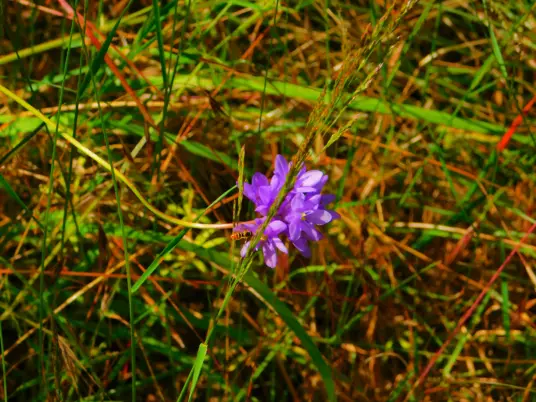Ookow? Oo-kay!
by Marcia Wilson
Student Intern: “We have ookows! There are ookows on the Flett!”
Dr. Faust: “Ookows? Oo-kay!”
(Text conversation from 2020 when ookows were “rediscovered” for the CPTC data charts)
Once a common sight in the western prairies from central California to Washington, ookows are a Junetime joy.
Also Known As:
Latin: Dichelostemma congestum, Blue-dicks, Snake Lily, Cluster-Lily, Fork-Toothed Ookow, Wild Hyacinth, Indian Potato. Incorrectly called “Wild Onions” because their cluster of flowers can look something like a garden onion’s bloom.
Asparagus, Lily, Potato, or Onion?
Ookows belong to the Asparagaceae which is commonly called the Asparagus Family after the favorite spring vegetable. Unlike its namesake relative, the edible parts of the ookow are below the ground. It is part of a group of different plants ethnobotanists call “Indian potato”. These plants are reliable food crops with an ethnic, cultural, and/or environmental significance to their native ecology.
Records in Western literature are surprisingly erratic, but ookow is a nutritious and trustworthy food in its native range.
Ookow is perfectly suited for commercial flowers because:
- it ripens on a long stalk free of leaves.
- Can conserve water as it is native to the hot, dry summers of Puget Sound.
- A cut flower can stay fresh for as long as one week in a vase.
- Cultivated plots can thrive for hundreds of years with only basic upkeep and maintenance.
The only real problem with the ookow is the length of bloom-time. A few weeks are as long as the ookow flowers. On the other hand, bloom time depends on latitude and altitude.
Oo-kay!
Ookows joined the CPTC Bloom Chart thanks to a work study student trying to rediscover “lost” plots of wildflowers under the attention of the late Professor Fritz. Instructor Kathy Smith had found a large paper map of emergent wildflowers that were of interest, but the map lacked fixed coordinates.
After weeks of walking across the field, ookow was re-discovered in an area labeled for false onions. It is easy to see why: ookows bloom like chives or common garden onions going to seed. They thankfully lack the pungent odors of onions!
In a world plagued by Scotch Broom, the ookow fights stubbornly for space. Part of its success may be in its ability to grow through the constrictions of the broom. With no leaves to get in the way, and a tall, thin flower-stalk it can reach through the branches to the nourishing sunlight. It can be found in the lightly dappled shade of Garry Oaks and the fringes of Douglas Fir groves.
In the CPTC uplands there is not a lot of predation by wildlife. A few moles and voles exist but not in enough numbers to make a difference for the flower. Areas where the native Mazama Western Prairie Gophers live can make protecting a treasured patch of bulbs a challenge. This is a pity; gophers are valuable soil aerators and fertilizers for native plants and ‘turn up’ minerals that benefit the ecology.
The Bees’ Needs
Ookow will need a few years to flower from seed, but once it does the nectar is a delight to a large and diverse range of insects. This includes five different kinds of swallowtail butterfly, two species of duskywings, and skippers. Native bees, pollinator flies, and hummingbirds are just as quick to fly in for a meal. Ornamental meadow herbs are still under-represented for the CPTC Outdoor Lab. Every year a little more invasive flora is removed, and replaced with natives. The preferred method of ookow propagation is by broadcasting. Volunteers must collect about 5% of the available seeds and scatter them in areas where they are likely to establish. At this point, planting ookow corms is too difficult.
The Future is (Firecracker) Bright
Appreciation has grown every year for native plants. Twenty years ago, it was difficult to find ornamental herbs such as Sea Thrift and Cliff Maids. –they are now sold in large-chain nurseries and stores. The blue-purple ookow may be joining this select group soon. Nurseries are responding to consumer concerns for lovely plants that can be self-sustaining, drought-tolerant, and capable of thriving in a range of soils and sun exposures.

For now, hope—and a splash of color—is available with one of the the closest relatives: Dichelostemma ida-maia is available for online shoppers. Called the Firecracker, its bright red flowers are native on the Pacific Coast up through Southwestern Oregon.
